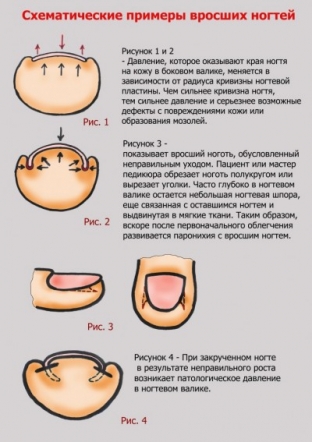In 95% of cases, such a nuisance happens to the big toes. If your nails have changed shape and color, pain occurs when walking, and the skin around the nails is reddened and inflamed – these are signs of onychocryptosis or ingrown toenails. A feature of this disease is that it can occur at any age and even subject to careful foot hygiene. Learn about the most common causes of an ingrown toenail and how it can be treated.
The main causes of ingrown nails
- Uncomfortable shoes (too narrow, constricting the foot).
- Incorrectly trimmed nail (corners of the nail plate cut too deep).
- Flat feet.
- Nail fungus.
- The specific structure of the big toes.
- Bruise or injury to the big toes in the area of the nail.
Any of these reasons can cause pain that will last for months, or maybe years. In view of this, one should still not resort to self-medication and not hope that the manicurist will help get rid of the problem of an ingrown nail. Measures taken on your own can only bring temporary relief, but over time, inflammation and pain will still return.
In the absence of proper treatment, over time, outgrowths of soft tissues begin to form around the nail, which, of course, does not have the best effect not only on sensations, but also on the appearance of the finger.
Ingrown toenail treatment: why you should not self-medicate
 In the case when the process of ingrown nails has already begun (there is inflammation, redness, pain), it is impossible to neutralize this problem on your own. Many try to treat an ingrown nail by applying brilliant green or iodine to the sore spot, but such actions can only provoke a burn and aggravate inflammation.
In the case when the process of ingrown nails has already begun (there is inflammation, redness, pain), it is impossible to neutralize this problem on your own. Many try to treat an ingrown nail by applying brilliant green or iodine to the sore spot, but such actions can only provoke a burn and aggravate inflammation.
Effective treatment of an ingrown nail in this case can only be carried out using surgical methods. The doctor will be able to determine the degree of ingrowth and decide what kind of operation is needed. Sometimes all it takes – it is to cut and straighten only the nail plate, if the stage is more advanced – you will have to resort to removing part of the growth zone using laser technology.
Modern treatment of an ingrown nailis painless and bloodless. It should be borne in mind that if the nail is affected by the fungus, the help of a dermatologist may also be needed.
How to prevent ingrown nails- Cut your nails correctly and in a timely manner – don't cut them too short, and don't cut them too round.
- Avoid bruising your fingers, and if injury does occur, treat it promptly.
- Never wear someone else's shoes, and wear rubber slippers in the shower and pool.
- Do not wear smaller shoes, avoid shoes that are too tight.
- If you have flat feet – use orthopedic insoles and massage your feet.






Add a comment